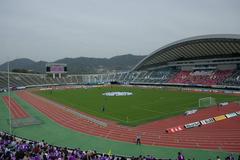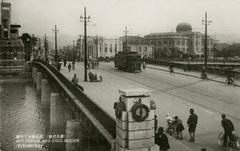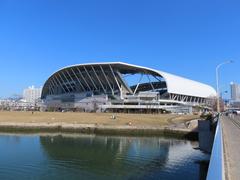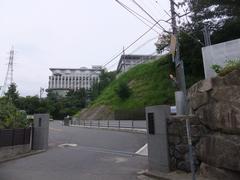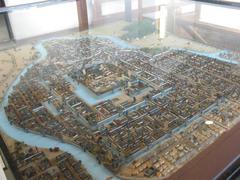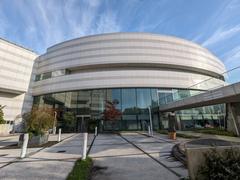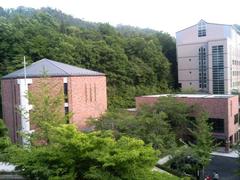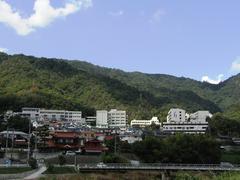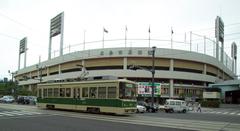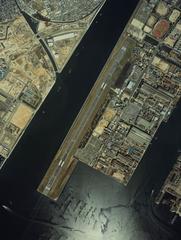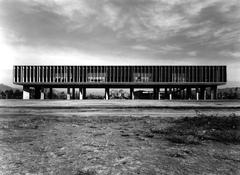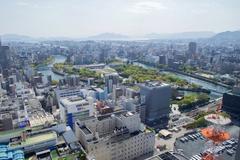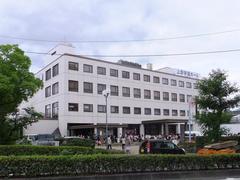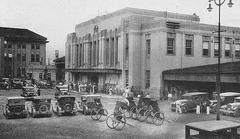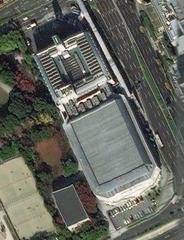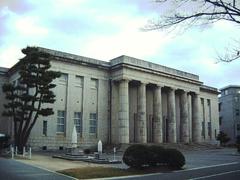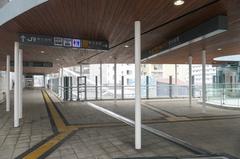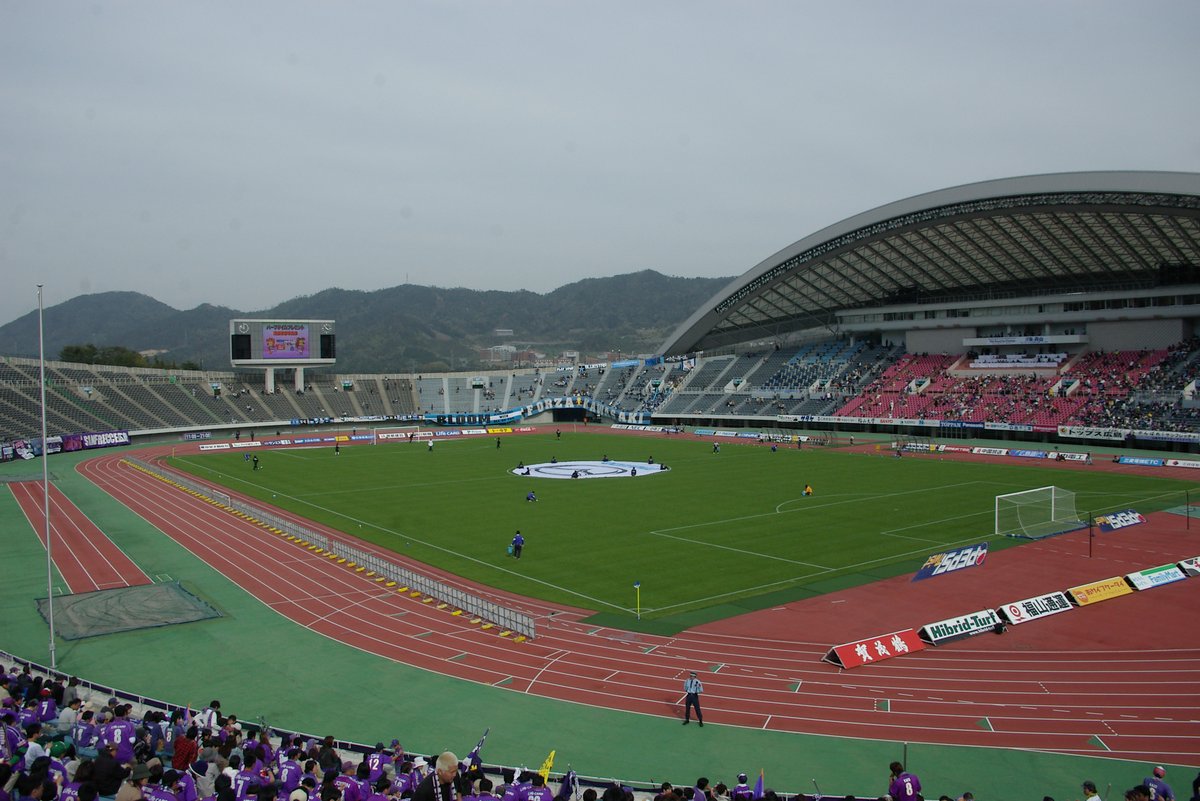
Hiroshima Big Arch: Visiting Hours, Tickets, and Guide to Hiroshima Historical Sites
Date: 14/06/2025
Introduction
Hiroshima Big Arch, officially known as Edion Stadium Hiroshima, stands as a testament to the city’s resilience, blending sports, culture, and history in one of Japan’s most significant urban landscapes. Since its inauguration in 1992, the stadium has served as a venue for major sporting and cultural events, notably hosting the 1992 AFC Asian Cup and the 1994 Asian Games. Beyond its role as an athletics and football hub, Hiroshima Big Arch is an enduring symbol of Hiroshima’s recovery and modern identity, drawing visitors eager to experience both its sporting atmosphere and its proximity to the city’s iconic historical sites (Wikipedia: Hiroshima Big Arch; City of Hiroshima).
This comprehensive guide provides up-to-date information on Hiroshima Big Arch’s visiting hours, ticketing, facilities, transportation, and nearby attractions, ensuring a memorable and informed visit for sports fans and history enthusiasts alike.
Table of Contents
- Introduction
- Historical Background and Cultural Significance
- Architectural Design and Features
- Visiting Hours and Ticketing
- Transportation and Accessibility
- Facilities and Amenities
- Nearby Attractions and Travel Tips
- Practical Visitor Tips
- FAQs
- Conclusion
- References
Historical Background and Cultural Significance
Origins and Early Development
Hiroshima Big Arch was constructed as part of a broader post-war modernization effort, aiming to transform Hiroshima into an international city of peace and culture. Its opening corresponded with the hosting of the 1992 AFC Asian Cup, marking a milestone in Japanese and Asian football history (Wikipedia: Hiroshima Big Arch).
Major Sporting Events
The stadium’s international profile was solidified by hosting not only the 1992 AFC Asian Cup but also athletics and football events during the 1994 Asian Games. These major competitions helped establish Hiroshima as a prominent destination for global sports (Football Tripper).
Community Impact and Modern Identity
For decades, Hiroshima Big Arch was home to the Sanfrecce Hiroshima football club, playing a crucial role in fostering community identity and pride. The stadium’s continued use for athletics, cultural festivals, and community gatherings has made it a central hub for local engagement and international exchange (Soccerphile; This Way to Japan).
Architectural Design and Features
Structure and Layout
Hiroshima Big Arch features a distinctive elliptical, open-air design with seating for approximately 36,894 spectators. Its signature arch-shaped roof covers the main stand and lends the stadium both its nickname and its visual identity. The layout includes four main stands—North, East, South, and West—offering diverse viewing experiences. The presence of an athletics track around the pitch enables multi-purpose use, though it does place some distance between the stands and the pitch (JSoccer; Football Tripper).
Multi-Functional Capabilities
Designed for versatility, the stadium regularly hosts football matches, athletic competitions, concerts, and large-scale community events. Its integration within the broader Kōiki Park provides additional recreational and sporting facilities for the public (City of Hiroshima).
Visiting Hours and Ticketing
Visiting Hours
Hiroshima Big Arch’s opening hours depend on scheduled events. On event days, gates typically open 1–2 hours before the start time. Public access on non-event days is limited, but guided tours may be available by prior arrangement. Always verify visiting hours through the official Sanfrecce Hiroshima website or event organizers for the most current information (Soccerphile).
Ticketing
Tickets for matches and events can be purchased online via the official Sanfrecce Hiroshima website, at authorized ticket outlets, or at the stadium box office on event days. Prices range from ¥2,300 for general admission to ¥5,000 for premium seating, depending on the event and seat category (JSoccer).
Transportation and Accessibility
Location
- Address: 1-1, Otsuka-nishi 5-chome, Asaminami-ku, Hiroshima City, Hiroshima Prefecture 731-3162 (Soccerphile).
By Public Transport
- Astram Line (AGT): The stadium is a five-minute walk from Koiki-koen-mae Station on the Astram Line, which connects central Hiroshima with the stadium area (National Stadium Tours).
- Shuttle Buses: On match days, shuttle buses run from Yokogawa Station (bus stop No. 4), operating every 10 minutes before kickoff. The ride takes about 20 minutes (National Stadium Tours).
By Car
- Driving from central Hiroshima takes around 20 minutes, but event days can see heavy traffic and full parking lots. Check parking details on the Sanfrecce Hiroshima website.
Accessibility
The stadium is equipped with ramps, elevators, wheelchair seating, and accessible restrooms. The Astram Line and shuttle buses are also wheelchair-friendly (Soccerphile).
Facilities and Amenities
- Seating: All-seater stadium with covered main stand; other stands are open-air.
- Weather Considerations: Partial roof coverage means visitors should bring rain gear or sun protection as needed (National Stadium Tours).
- Food and Drinks: On event days, food stalls offer Japanese snacks and local specialties such as Hiroshima-style okonomiyaki. Outside, convenience stores and restaurants are within walking distance.
- Restrooms: Accessible toilets are distributed throughout the stadium.
- Merchandise: Official Sanfrecce Hiroshima merchandise is available at stadium shops and select locations citywide.
- First Aid and Information: Staffed counters and medical stations are present for visitor support.
Nearby Attractions and Travel Tips
Historical and Cultural Sites
- Hiroshima Peace Memorial Park and Museum: Commemorates atomic bombing victims and promotes peace (Soccerphile).
- Atomic Bomb Dome: UNESCO World Heritage Site and symbol of resilience.
- Hiroshima Castle: Offers insights into the city’s feudal past.
- Miyajima Island: Famous for Itsukushima Shrine and scenic beauty.
- Kure and Battleship Yamato Museum: Explores Japan’s maritime history (National Stadium Tours).
Accommodation
- Mitsui Garden Hotel Hiroshima: Centrally located, upscale hotel.
- APA Hotel Hiroshima-Ekimae Ohashi: Convenient for travelers arriving by Shinkansen.
Local Cuisine
- Hiroshima-style okonomiyaki: A must-try local specialty.
- Oysters: Popular in winter.
- Momiji Manju: Maple-leaf-shaped sweet buns, ideal as souvenirs (National Stadium Tours).
Practical Visitor Tips
- Arrive Early: Especially on event days, to avoid congestion and secure preferred seating.
- Weather: Prepare for variable weather; bring rain gear or sunblock depending on the season.
- Cash and Cards: Some vendors may only accept cash, so carry yen in addition to cards.
- Photography: Panoramic shots of the stadium and surrounding mountains are recommended.
- Language: English signage is available at major locations, but basic Japanese phrases or a translation app can enhance your visit.
FAQs
Q: What are Hiroshima Big Arch visiting hours?
A: Hours are event-dependent. Gates generally open 1–2 hours before start time. Check the official website for details.
Q: How can I buy tickets?
A: Purchase online through the Sanfrecce Hiroshima website, at ticket outlets, or at the stadium box office.
Q: Is the stadium accessible for disabled visitors?
A: Yes, it offers accessible seating, restrooms, and transport options.
Q: What is the best way to reach Hiroshima Big Arch?
A: The Astram Line to Koiki-koen-mae Station is fastest and most convenient; shuttle buses operate on event days.
Q: Are there guided tours?
A: Guided tours may be available by appointment on non-event days; check with the stadium in advance.
Q: What nearby attractions should I visit?
A: Peace Memorial Park, Atomic Bomb Dome, Hiroshima Castle, and Miyajima are all recommended.
Conclusion
Hiroshima Big Arch is far more than a stadium—it is a living symbol of Hiroshima’s journey from destruction to renewal and a vibrant center for sports, culture, and community. Whether you are attending a football match, exploring the city’s historical sites, or experiencing its local cuisine, the stadium’s accessibility, facilities, and surroundings ensure a rewarding visit. For the latest information on visiting hours, tickets, and events, consult official resources and plan ahead to make the most of your Hiroshima adventure.
References
- Wikipedia: Hiroshima Big Arch
- Hiroshima Big Arch Stadium: Architectural Marvel, Cultural Icon, and Visitor Guide
- Soccerphile: Edion Stadium Hiroshima Visitor Guide
- Trip to Japan: Top 10 Must-Visit Historical Sites in Hiroshima
- City of Hiroshima Official Website
- National Stadium Tours: Hiroshima Big Arch
- This Way to Japan: Hiroshima Travel Guide
- Kanpai Japan: Hiroshima
- World Bank: What Hiroshima’s Recovery Can Teach Modern Cities About Urban Land
